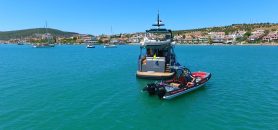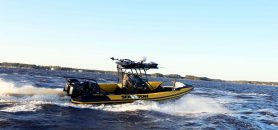Hysucat technology: planing is fun but foiling is electric

Getting boats to fly above the water surface is simple in theory, but tricky in practice and has challenged designers for over a century. Starting from 1980s some huge advances was made in this direction. Not just for fun or sports, but to gain some day to day functional advantages and enhanced efficiency. The new foiling technology once invented for military usage in 1980 found its way in service boating and RIB tenders used for varied purposes.
Since the creation of RIB boats in early 1970s development concentrated on enhancing power capability and materials used. Hard hull slamming, instability and increasing fuel consumption were considered as unbeatable side-effects for long time. Until in the beginning of 1980s when two men in the University of Stellenbosch in South Africa enhanced RIB technology with catamaran hulls and foils. This may sound easy but in reality combining these elements demanded years of try-and-test with dozens pages’ data analysis and engineering searches. Why so serious?
Foiling refers to the use of hydrofoils attached to the hull of fast boats, which provides additional lift at planing speeds – often enough to lift the hull completely clear of the water. Foils work in a similar way to aircraft wings. In simple terms, as they move through the water they deflect the flow, which exerts a force on the foil. If that force is upward, the faster they move, the greater the lift.
Foiling may seem like a recent technological phenomenon but it has actually been 100 years in the making. The first development of a foiling water vessel was a 60hp motorboat designed and built by Italian inventor Enrico Forlanini in 1906, obtaining patents in both the UK and the USA. He had a prototype operating on Lake Maggiore soon after. British boat designer John Thornycroft followed up with a series of scale models featuring stepped hulls and a single foil, and by 1909 had a full-scale 22ft prototype running. Later, in 1919, Alexander Graham Bell broke the world marine speed record with his Hydrodrome 4. During WWII, the German military developed a 17-tonne foiling mine layer that was tested in the Baltic at speeds of up to 47 knots. By the early 1950s, the first commercial hydrofoil ferry was running between Italy and Switzerland and a decade later, a private hydrofoil yacht featured in the Bond movie Thunderball.
It wasn’t until the 1960’s and 1970’s that foiling technology was introduced to the military and used commercially with the launch of the Boeing Jetfoil, first serving the Hawaiian Islands and later Hong Kong and Macau.
Traditionally, high-speed hydrofoils used large V-shaped foils that jutted out beyond the boat’s beam. This made berthing tricky and increased the draught. They were also costly to construct, vulnerable to damage and difficult to power, as the propellers of conventional shaftdrives would be clear of the water once foiling. Lastly, although hydrofoils were often more efficient than conventional hulls, high-speed cats could usually match the efficiency without the drawbacks. The problem was decreasing stability of catamarans at high speed.
These facts served as starting point for further research for speed boat racer Malan Conradie and Professor Gunter Hoppe, a world authority on hydrofoil technology and head of Marine Dynamics at the University of Stellenbosch in South Africa. The idea of development fast, stable and efficient foil-assisted catamaran hull without side-effects fascinated the duo and studies begun.
For 15 years, Conradie had worked with Professor Hoppe. Conradie did the technical design, interior and exterior design work, and Professor Hoppe designed the hydrofoils. All designs were tested the test tank facility at the university and sea trials were carried out to evaluate the hydrofoil concept. At later stage Conradie took the beta-version hull to the offshore powerboat events where it proved its superior design by outperforming the competition.
This collaboration resulted in the birth of the original Hysucat – “Hydrofoil Supported Catamaran ” – which led to a new breed of hull designs that became popular in South Africa and later worldwide. The resulting company took the name of the new concept as its own – Hysucat. There should be noted, that as original patents had expired now large number of hydrofoil-supported cat-hulled vessels (from 6m to 50m in LOA) are using the Hysucat technology without using the original brand.
So what exactly is so special about Hysucat? First it is the hull or, to be more specific – hulls consisting of an asymmetrical, planing catamaran hull and special hydrofoil system.
The main hydrofoil fitted between the catamaran hulls acts like any classic foil operating in a fluid medium – the top surface generates a low pressure area, the lower surface a high pressure area and the mass of water flowing past the foil is deflected downwards. The resultant is lift generated far more efficiently than the hull planing surfaces – typically the Lift/Drag ratio of a planning hull is 4:1 while that of the hydrofoil is 20:1.
The main foil a stainless steel wing in the shape of a chevron, positioned slightly ahead of the boat’s center of gravity that spans the tunnel created by the catamaran hulls. It is parallel with – but not protruding below – the bottom of the hulls, meaning that the wing is always in the water and that there may be some protection for it in case of accidental grounding. There is no doubt that air trapped and compressed in the tunnel at higher speeds will also add to the lift potential before passing through the end of the tunnels at the transom.
Smaller trim hydrofoils are also fitted on the inside of the catamaran tunnel near the transom. These smaller foils play an important role in the automatic longitudinal trim stabilization of the hull in that as they approach the water surface in the catamaran tunnel, the bow trims down, their lift decreases (due to free-surface effects) and then, due to lift reduction, the transom trims back down again.
In general, the hydrofoils are protectively fitted between the catamaran hulls as they are fitted to the hull keels as deep as possible so as to keep them fully submerged but no lower than the keels – as they do not protrude below the hull nor are they wider than the tunnel beam, there are no operational or aesthetic constraints as a result of fitting Hysucat hydrofoils.
Generally speaking the Hysucat design offers the best features of a monohull and a catamaran combined. While starting to accelerate the foil-assisted boat overcomes its own bow wake easily without engine overpowered effort needed for monohull or average catamaran. This is really important in choppy waters when “normal” cats tend to bury in waves.
The advantages of this unique, hybrid system is that it further amplifies many of the existing benefits of the catamaran hull-form. These are
• Due to catamaran-shaped hulls Hysucat designed boats have reduced running resistance. Therefore, high speeds can be reached much easier with lower-powered engines with up to 70% less fuel consumption. This gives two-folded advantage in terms of cheaper engine set-ups and smaller fuel expenses.
• Consuming less fuel for propulsion, the Hysucat design dramatically broadens the cruising range of the boat. Hysucat can go much further for less time and money.
• Improved ride quality in rough seas due to the motion damping effect of the hydrofoils.
• Easy, monohull-like control. The foils do not impair handling nor create directional-instability or broaching problems. Although sensitive to handle, Hysucat do not need special handling techniques.
• Hysucat foil-assisted boats can reach up to 50-60 mph speeds with 30-35 mph as average cruising. Again such figures are reached with less resources both engine and fuel-wise.
Furthermore, some of the advantages are felt only while riding the Hysucat boat. First effect is low spray noiseless dry ride of the foil-assisted boat. Due to lifting effect and low resistance, there is less slamming and in turn less spray from the bottom of the boat. So there’s no need to overdress the guests and personnel with protective (and expensive) water-proof outfit.
Essential point of difference is load bearing capacity. The forces that are created by foils are working almost regardless of weight. The payload of the Hysucat foil-assisted boat is twice bigger than the average boat. Hysucat is less sensitive to the load distribution as well. Figures prove that 8m Hysucat can easily blast with up to 12 guests onboard.
Again, with less slamming and as a result – less shaking of the vessel come such important feature as no-fatigue effect. This is essential for a pleasant ride for those not familiar with sea or fatigue-vulnerable by nature.
Last but not least, the catamaran-shaped hull provides wider beam and greater storage – precious commodity for the RIBs.
With this some suggestions must be acknowledged. First issue that is always raised is foils prone to impacts. Reported tests and real issues show that normal production foils can survive some object-hitting but not hard grounding on rocky bottom. Serial producers propose break-away setups that help to protect the hulls in case of really severe impacts.
The other point is the complex construction process with extremely tight allowances for foils production. This means thoughtful selection of the producers that deliver the boat able to show the foil-technology in full effect.





